 |
 |
 |
| |
Body Composition Changes in ARV-Naive Subjects Treated With Atazanavir or Atazanavir/Ritonavir-Based Once-Daily HAART: 48-Week CT and DEXA Data
|
| |
| |
Reported by Jules Levin
CROI Feb 2007, LA
Donnie McGrath, David Frederick, Victoria Wirtz, Rong Yang, Alexandra Thiry, Marina Mathew, Mustafa Noor, Bristol Myers Squibb
A group from BMS reported no negative effects on changes in lipoatrophy after 48 weeks for ART-naive patients on Reyataz or Reyataz/r from study 089.
Summary: there was no decline in SAT on ATV/RTV or ATV. In fact, SAT increased by 12-13% from baseline to week 48. VAT increased by 26-33% from baseline to week 48 for both ATV/RTV & ATV treatment groups. Body fat changes by DEXA showed an increase in trunk fat of 12-15%. But there was no significant change in limb fat for either ATV/RTV or ATV, as limb fat increased by 2% for patients on ATV/RTV and decreased by 3% on ATV. Total body fat by DEXA increased 7% on ATV/RTV & 6% on ATV. Regarding changes in lipids, There were small increases in lipid parameters for both ATV/RTV & ATV from baseline to week 48 but the values were below NCEP cutoffs at baseline & remained below these cutoffs at week 48. (cutoffs: 200 mg/dL for total cholesterol; 130 mg/dL for LDL chol, 40 mg/dL for HDL (for this parameter, HDL increased from below 40 to just over 40 for both regimens); fasting triglycerides increased for ATV/RTV from 115 to 130 mg/dL from baseline to week 48 for ATV/RTV but decreased for patients on ATV.
The authors concluded:
"In HIV-infected ARV-naive subjects, after 48 weeks of treatment with RTV-boosted ATV or ATV regimens, comparable changes in body composition as assessed by CT or DEXA imaging were observed. Neither regimen caused significant increases in clinician-assessed rates of lipodystrophy or lipohypertrophy as measured through LCD scores".
The BMS 089 study was a randomized, open-label, multicenter, 96-week study designed to compare the efficacy and safety of ATV/RTV with that of ATV in HIV treatment-naive subjects.
There were significant mean percentage increases from baseline in adipose tissue parameters at 48 weeks; however, there were no significant differences between the two treatment groups.
The ATV400 regimen had greater trunk-to-total and trunk-to-limb ratio increases and a greater limb-to-total ratio reduction. These differences may be explained by the greater increase in trunk fat on this regimen compared with the ATV300/RTV regimen.
Lipid and body habitus changes through 48 weeks in patients who have received
ATV-based HAART regimens have been consistent among various studies in HIVpositive patients7,8 and are consistent with a return to health among treatment-naive patients who start HAART.7
In accordance with previous findings and in contrast with results for other PIs,3
ATV did not result in clinically significant increases in total cholesterol, fasting LDL cholesterol, non-HDL cholesterol, or fasting triglyceride levels in this 48-week study in treatment-naive patients.
METHODS
In the 089 study, treatment regimens included:
-- ATV 300 mg once a day (QD) + RTV 100 mg QD + lamivudine (3TC) 300 mg QD + stavudine (d4T) extended-release 100 mg QD
or
--ATV 400 mg QD + 3TC 300 mg QD + d4T extended-release 100 mg QD
Treated subjects had cross section computed tomography (CT) and dual energy x-ray absorptiometry (DEXA) scans at baseline, Week 24, and Week 48. Data from subjects with paired CT and/or DEXA scans at baseline and Week 48 were included in the analyses presented here.
CT/DEXA parameters were summarized for visceral adipose tissue (VAT),
subcutaneous adipose tissue (SAT), total adipose tissue (TAT), and trunk, limb, and total body fat using the actual values, the changes from baseline, and the percent changes from baseline at each scheduled scan through Week 48.
Fat redistribution was assessed using the LCD scores derived from the Study of Fat Redistribution and Metabolic Change in HIV Infection (FRAM) survey.9
Gender subgroup analyses were conducted, as were assessments of lipid and
metabolic changes.
HOMA-IR was defined as insulin x glucose/(22.5 x 18.018).
Treatment regimens and the magnitude of change were compared using the difference in mean percent changes from baseline at Week 48 for each CT/DEXA parameter with 95% confidence intervals (CIs) and P values based on t tests.
RESULTS
Demographics and Baseline Characteristics
Subjects (N = 172) were well matched between groups and baseline characteristics were comparable (Table 1); baseline characteristics were similar to those of all subjects in the primary study cohort (N = 200)8
Table 1. Baseline Demographics
Median CD4 count was about 200 with 45-53% having <200 CD4s. Median weight was 68-70 kg. Median waist circumference was 82 cm. Median age was 35, 72% were men. 55% were White, 27% Black. Median HIV RNA was 4.79-5.08 log with HIV RNA >100,000 in 38-51%.
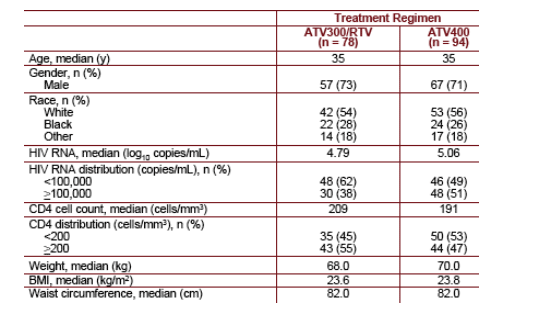
Efficacy
Subjects on both regimens had comparable reductions in median HIV RNA levels
at Week 48 from baseline (ATV400: -3.13 log10 copies/mL; ATV300/RTV: -3.07
log10 copies/mL). These were comparable to those of the primary cohort
Adipose Tissue Changes
Both regimens were associated with comparable and statistically significant mean percentage increases in VAT, SAT, and TAT at 48 weeks from baseline
(Figure 1), but there were no significant differences between treatment groups.
Figure 1. Adipose Tissue Changes
This graph shows SAT, subcutaneous adipose tissue increased by 10-12% in both treatment arms at 48 weeks, and VAT, visceral adipose tissue increased by 27% in the ATV/RTV arm & 35% in the ATV arm. TAT increased 20% in both arms.
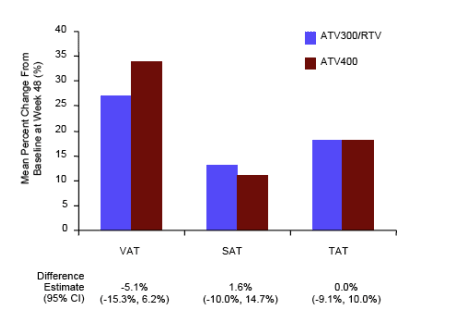
At 48 weeks, in both regimens, the ratios of visceral and subcutaneous compartments to total abdominal fat were associated with small but statistically
significant changes from baseline (Table 2).
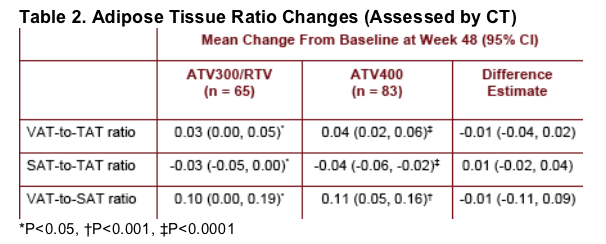
Body Fat Changes
Overall there was a small increase in total body fat in both regimens. Subjects on
each regimen had comparable and statistically significant mean percentage
increases in trunk fat at 48 weeks from baseline, without an associated limb fat
loss (Table 3).
Table 3. Body Fat Changes (Assessed by DEXA)
By DEXA this table reports there was very little change in limb fat in the ATV/RTV arm (2%) and the ATV arm (-3%). Trunk fat increased by 12% in the ATV/RTV arm and by 15% in the ATV arm. Total body fat increased by 7% in the ATV/RTV arm and by 6% in the ATV arm.
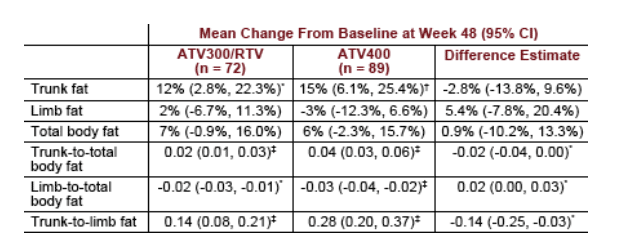
Gender Differences
Within each regimen at Week 48:
-- Men and women had comparable mean percentage increases in VAT (Figure 2).
-- Women had larger increases than men in SAT and TAT while men had larger
changes in VAT-to-SAT ratios
Figure 2. Gender Differences in VAT and Total Body Fat
This graph shows increases in VAT by CT of 20-25% for men & women on ATV/RTV, and increases of 35-38% on ATV. Total body fat (by DEXA) increased 5% for men on ATV/RTV & 15% for women on ATV/RTV. For patients on ATV, total body fat increased 5% for men & 13% for women.
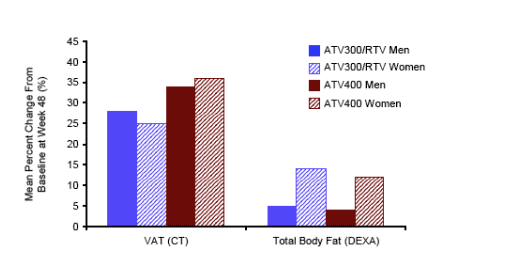
Lipodystrophy Case Definition Scores
Subject-reported responses to changes in body fat were comparable between
regimens at Week 48 (Table 4).
Table 4. Self-Reported Lipodystrophy Case Scores
Change in cheek fat: 20% in ATV/RTV reported yes, 20% in ATV reported yes; 56% on ATV/RTV reported no, 60% on ATV reported no.
Change in arm fat: 20% on ATV/RTV reported yes, 22% on ATV reported yes.
Change in abdominal fat: 40% on ATV/RTV reported yes; 36% on ATV reported yes. 39% on ATV/RTV reported no, 42% on ATV reported no.
Change in waist size: 41% on ATV/RTV reported yes; 33% on ATV reported yes. 39% on ATV/RTV reported no, 46% on ATV reported no.
Change in leg fat: 22% on ATV/RTV reported yes; 24% on ATV reported yes. 58% on ATV/RTV reported no, 57% on ATV reported no.
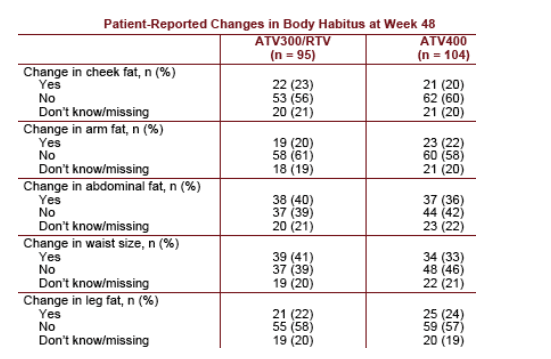
For all body regions, the majority of investigator-reported severity category changes for subjects who were normal at baseline were also normal at Week 48.
Changes in the proportions of subjects with investigator-reported lipohypertrophy
and lipoatrophy were comparable between regimens at Week 48 (Figure 3).
Figure 3. Proportions of Subjects With Investigator-Reported Lipohypertrophy and/or Lipoatrophy at Baseline and Week 48
There was no increase in investigator reported lipoatrophy from baseline to week 48 for either regimen. In the ATV regimen investigators reported a decline in lipoatrophy from 10% at baseline to 5% at week 48. For patients on ATV/RTV there was a reported 5% lipoatrophy at baseline & week 48. Lipohypertrophy increased from baseline to week 48 for both treatment groups: from 5% to 12% on ATV/RTV and from 8% to 13% on ATV.
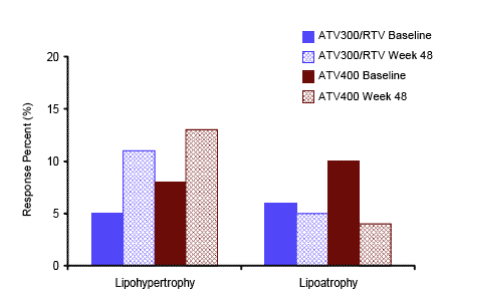
Lipid, Metabolic, and Weight Changes
Lipids and lipoprotein changes at Week 48 are shown in Figure 4.
HDL-cholesterol increases were observed at Week 48 for both regimens.
Figure 4. Lipid Median Values
Values reported here by me are based on visual readings from bar graph below. There were similar increases in total cholesterol for both regimens and the same for LDL, but the values remained below the cutoffs of 200 mg/dL for total cholesrol & 130 mg/dL for LDL-cholesterol. For total cholesterol for patients on ATV/RTV median value changed from 155 to 175 from baseline to week 48. For patients on ATV the increase appeared to be a little less from 160 to 170. For fasting LDL patients on ATV/RTV had 90 at baseline & 115 at week 48. For patients on ATV they had 100 at baseline & 120 at week 48. For HDL values appears to equally increase for both regimens from just below 40 to several points above 40. For triglycerides patients on ATV/RTV had increases from 110 at baseline to 135 at week 48. For patients on ATV baseline median value was 130 at baseline and 120 at week 48. For non-HDL baseline value was 115 for ATV/RTV and an increase to 125 at week 48. For patients on ATV non-HDL was 125 and did not change at week 48.
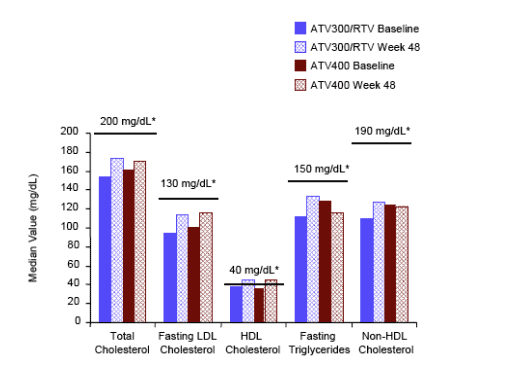
The mean changes in body mass index (ATV300/RTV 1.3 kg/m2; ATV400 1.1 kg/m2) and waist circumference (ATV300/RTV 4 cm; ATV400 3 cm) were small and comparable between regimens at Week 48. There were no marked changes in waist-to-hip ratios.
Metabolic changes from baseline at Week 48 are shown in Table 5.
Table 5. Change From Baseline in Glucose Metabolic Parameters at 48 Weeks
Fasting glucose did not change in either group. Fasting insulin increased by 1 mg/dL in both groups. Fasting HOMA-IR increased by 0.09 in ATV/RTV group & 0.31(mg/dL x uU/mL) in ATV group. Weight increased by 4 in ATV/RTV & by 3 in ATV group.
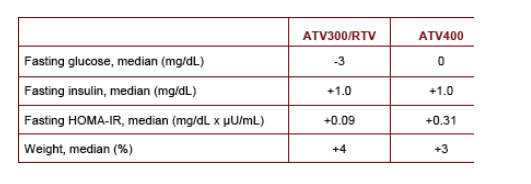
|
| |
|
 |
 |
|
|